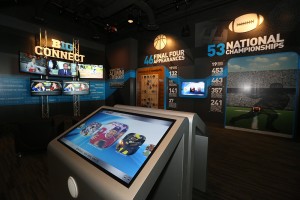 ROSEMONT, Ill. – The University of Maryland and Rutgers University became official members of the Big Ten Conference today, increasing the Big Ten’s membership to 14 institutions. In addition, Johns Hopkins University officially became a sport affiliate member for men’s lacrosse.
ROSEMONT, Ill. – The University of Maryland and Rutgers University became official members of the Big Ten Conference today, increasing the Big Ten’s membership to 14 institutions. In addition, Johns Hopkins University officially became a sport affiliate member for men’s lacrosse.
The Big Ten now boasts more than 520,000 total students and 5.7 million living alumni. The conference’s broad-based athletic programs will feature almost 9,500 student-athletes for more than 11,000 participation opportunities on 350 teams in 42 different sports, including 28 official Big Ten sports. Maryland and Rutgers are already members of the Committee on Institutional Cooperation (CIC), an academic consortium of Big Ten universities and the University of Chicago that is a highly regarded model for effective and voluntary collaboration among top research universities. In 2012, CIC institutions produced over $10 billion in research expenditures.
Maryland and Rutgers will take part in their first Big Ten event as official members of the conference at the 2014 Football Media Days and 43rd annual Kickoff Luncheon. This year’s event will be held on Monday and Tuesday, July 28 and 29, at the Hilton Chicago. The Big Ten Football Media Days and Kickoff Luncheon feature all 14 head coaches and some of the nation’s top returning players.
The Terrapins and Scarlet Knights will each take part in their first athletic competition as members of the Big Ten Conference with a pair of women’s soccer games onAugust 22, when Maryland visits UCLA and Rutgers hosts Stony Brook. The two institutions open Big Ten competition on September 12 when Maryland hosts Rutgers in women’s soccer. That same day in men’s soccer, Maryland visits Michigan and Rutgers travels to Wisconsin. The 2014 cross country, field hockey, golf, tennis and volleyball seasons will begin in late August and early September.
The Rutgers football team begins its first season as a Big Ten program on August 28 at Washington State. Two days later, Maryland’s football squad will do the same with a home game against James Madison. The Scarlet Knights will make their debut in Big Ten action at home against Penn State on September 13. The Terrapins will open conference play at Indiana on Sept. 27, before hosting Ohio State in their first Big Ten home game on Oct. 4. The conference’s two newest members will meet on November 29 at Maryland in the final week of the regular season.
The 2014 football season will feature new division alignments, with Maryland and Rutgers joined by Indiana, Michigan, Michigan State, Ohio State and Penn State in the East Division. Illinois, Iowa, Minnesota, Nebraska, Northwestern, Purdue and Wisconsin will play in the West Division. A representative from each division will play in the Big Ten Football Championship Game on Dec. 6 at Lucas Oil Stadium in Indianapolis, with the winner earning the Big Ten Championship.
The cross country teams from Maryland and Rutgers will have the first opportunity to compete in a Big Ten Championship, with both schools taking part in the 2014 Big Ten Cross Country Championships to be hosted by Iowa on Nov. 2.
The inaugural season of Big Ten men’s and women’s lacrosse will begin in 2015, with Maryland, Michigan, Ohio State, Penn State and Rutgers playing both sports, Johns Hopkins participating in men’s lacrosse and Northwestern competing in women’s lacrosse. The Terrapins and Scarlet Knights will host their first Big Ten Tournaments beginning in April, with the inaugural men’s tournament held from April 30 to May 2 at Maryland and the first women’s event hosted by Rutgers from April 30 to May 3.
Since the announcement to add Maryland and Rutgers in November 2012, the Big Ten has made a series of announcements highlighting the conference’s increased presence on the East Coast. Last June, the Big Ten announced an agreement to take part in the New Era Pinstripe Bowl, sending conference football teams to play at Yankee Stadium on an annual basis. In April, the Big Ten announced that it would open a second office in New York City while securing access to satellite office space in Washington, D.C. In May, the conference unveiled plans to take part in the Gavitt Tipoff Games, an annual early-season men’s basketball series with the Big East named in honor of Dave Gavitt, and announced that the 2017 Big Ten Men’s Basketball Tournament will be held at the Verizon Center in Washington, D.C. Also in May, BTN confirmed that the network had reached deals with Time Warner Cable and Cablevision for broad distribution to their subscribers in the New York/New Jersey television markets. In June, BTN confirmed that a similar agreement was reached with Comcast for broad distribution in Maryland and New Jersey.



